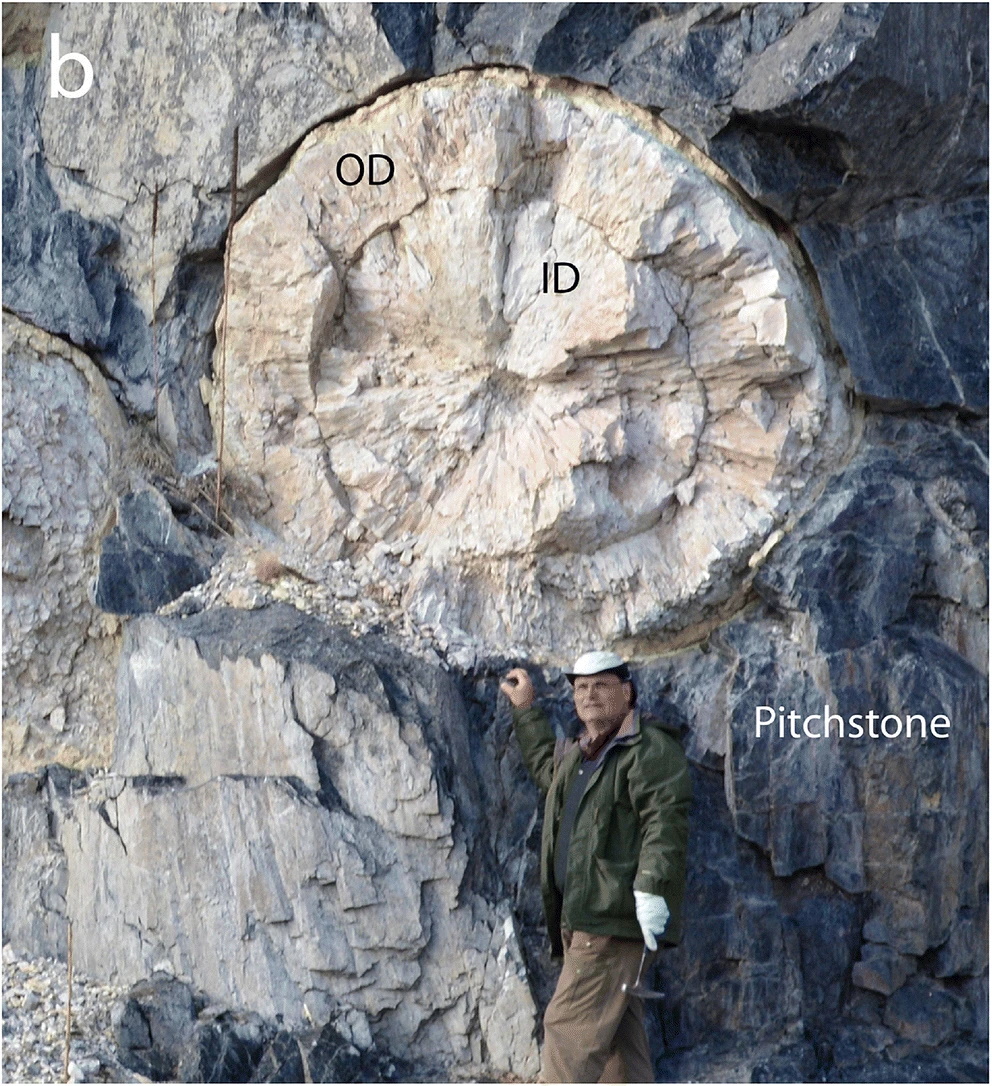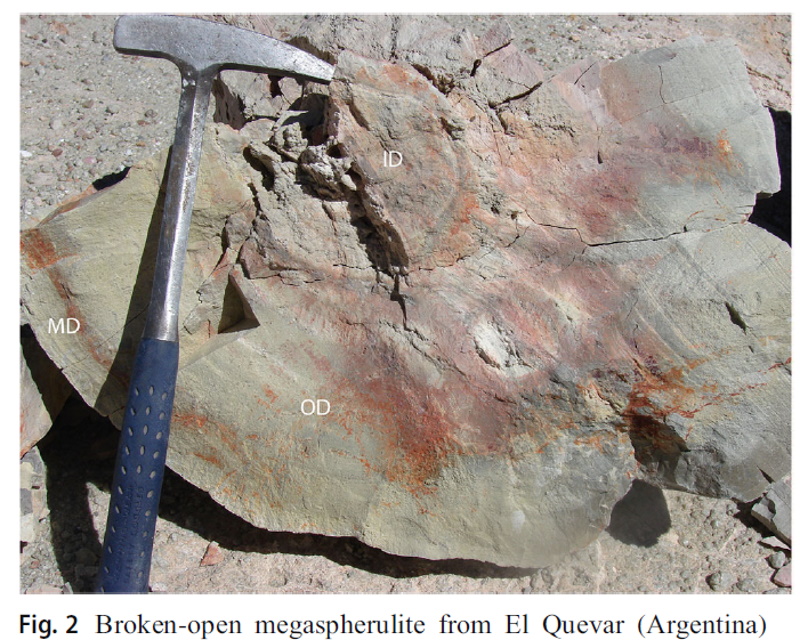Post by 1dave on Mar 2, 2022 3:37:20 GMT -5
link.springer.com/content/pdf/10.1007/s00445-021-01434-7.pdf
Typical of the megaspherulite occurrences studied here is the scarcity or absence of small spherulites in the lava host. For the megaspherulites near Silver Cliff, CO, Smith et al2001) assumed “sparse heterogeneous nucleation, under highly non-equilibrium conditions” as the main controlling parameters.
Megaspherulites with diameters up to 4.3 m have been reported from lava and ignimbrites in the Western US (Steens Mountains and Opal Butte in Oregon, Klondyke in Arizona, and Silver Cliff in Colorado), from Argentina and from Mexico (Stirling 1969; Smith et al. 2001; Breitkreuz 2013; Bustos et al. 2020). Ottens and Götze (2016) mentioned meter-sized megaspherulites from various localities in China.
The present study describes and compares megaspherulites from three localities: (i) Silver Cliff megaspherulites (SCM; Smith et al. 2001), (ii) El Quevar megaspherulites in northwestern Argentina (EQM; Willson et al. 1999), and (iii) Meissen lava megaspherulites (MLM; Jentsch 1981). Some of the megaspherulites contain cavities and thus should be coined megalithophysae; however, the name megaspherulite is established in literature.

Silver Cliff megaspherulites
Knowledge about the spectacular megaspherulites in a pitchstone quarry north of Silver Cliff (CO) goes back to the end of the nineteenth century (Cross 1891; overview in Smith et al. 2001). The hosting Paleogene lava, 76–106 m thick, covering approximately 3 km2, is vertically subdivided into three zones (Siems 1968; Smith et al. 2001): (i) a lower perlitic vitrophyre, (ii) a middle rhyolitic vitrophyre, and (iii) an upper thick, flow-layered lithoidal rhyolite, with small spherulites at its base. The megaspherulites occur in the upper portion of the middle zone, isolated or in clusters (Fig. 1). Thirty-seven (mega-)spherulites of 0.2 to 4.3 m have been observed/collected by Smith et al. (2001) in the 58-m-wide Black Obsidian Quarry

El Quevar megaspherulites
On the southern flanks of the El Quevar-Azufrero stratovolcano complex in northwest Argentina, the perlitic rhyolitic Quirón lava dome formed during the Miocene (Willson et al. 1999). For this dome, Laurenzi et al. (2007) published a 40Ar/39Ar age of 8.77 ± 0.09 Ma. The EQMs (Fig. 2) occur in the upper part of a > 30-m-thick, fractured green, aphyric perlitic pitchstone, which is covered by < 3 m of white, relatively devitrified, rhyolite with a flow banded structure (Willson et al. 1999). The pitchstone contains small phenocrysts of biotite (2 vol%), plagioclase feldspar (2 vol%), and quartz (l vol%). The ellipsoid lithophysae (10–70 cm) mainly consist of quartz and plagioclase. Willson et al. (1999) also mentioned chevron-shaped cavities in the outer marginal zone. The focus of the contribution by Willson et al. (1999) was the FTIR of lithophysae, hosting perlitic pitchstone and obsidian (Apache’s tears). Next to silicate minerals in the HTCD (feldspar, quartz, cristobalite, biotite), the authors detected the presence of H2O and OH− in both the megaspherulites and the perlitic host.
One of us (CB) sampled fragments of megaspherulites and of decimeter-sized spherulites at the Quirón quarry in 2007.
Mineralogical and geochemical investigation of megaspherulites from Argentina, Germany, and the USA
Christoph Breitkreuz1 & Jens Götze2 & Alexandra Weißmantel2 Received: 22 July 2020 /Accepted: 5 January 2021
# The Author(s) 2021
Abstract
Textures and whole-rock chemistry, as well as mineral composition, were analyzed in megaspherulites (high-temperature crystallization domains [HTCDs]) that formed in different geographical and geotectonic contexts and during different geological periods (Silver Cliff, CO, USA—Paleogene; El Quevar, Argentina—Miocene; Meissen Volcanic Complex, Germany—Late Carboniferous).
All of these megaspherulites have formed exclusively in rhyolitic lava, and their mineral composition is dominated by K-feldspar (sanidine) and SiO2 phases (quartz, cristobalite, tridymite). All megaspherulites represent composite HTCDs, comprising three zones: inner domain (ID), outer domain (OD), and a marginal domain (MD). Early evolution of megaspherulites is characterized by either central cavities and sector- to full-sphere spherulites or dendritic quartz-sanidine domains. The latter consist of bundles of fibrils each radiating from a single point reflecting relatively high growth rates. A common feature of OD and MD of all three megaspherulite occurrences is autocyclic banding. It mainly comprises fibrous (≤100 μm length), radially oriented sanidine and quartz, which formed at a temperature close to glass transition temperature (Tg). The termination of megaspherulite growth is marked by centimeter-sized sector-sphere spherulites on the surface.
Megaspherulite formation requires limited nucleation, which is probably related to the low phenocryst content of the hosting lava. Latent heat from overlying crystallizing lithoidal rhyolite maintained low undercooling conditions keeping nucleation density low and facilitating high diffusion and growth rates. Late megaspherulite growth and its termination under low diffusion conditions is controlled by cooling close to Tg. Calculations based on literature data suggest that the megaspherulite growth presumably lasted less than 60 years, perhaps 30 to 40 years.
Keywords Rhyolitic lava . SEM . CL . XRD . EPMA . Cristobalite . Tridymite
Christoph Breitkreuz1 & Jens Götze2 & Alexandra Weißmantel2 Received: 22 July 2020 /Accepted: 5 January 2021
# The Author(s) 2021
Abstract
Textures and whole-rock chemistry, as well as mineral composition, were analyzed in megaspherulites (high-temperature crystallization domains [HTCDs]) that formed in different geographical and geotectonic contexts and during different geological periods (Silver Cliff, CO, USA—Paleogene; El Quevar, Argentina—Miocene; Meissen Volcanic Complex, Germany—Late Carboniferous).
All of these megaspherulites have formed exclusively in rhyolitic lava, and their mineral composition is dominated by K-feldspar (sanidine) and SiO2 phases (quartz, cristobalite, tridymite). All megaspherulites represent composite HTCDs, comprising three zones: inner domain (ID), outer domain (OD), and a marginal domain (MD). Early evolution of megaspherulites is characterized by either central cavities and sector- to full-sphere spherulites or dendritic quartz-sanidine domains. The latter consist of bundles of fibrils each radiating from a single point reflecting relatively high growth rates. A common feature of OD and MD of all three megaspherulite occurrences is autocyclic banding. It mainly comprises fibrous (≤100 μm length), radially oriented sanidine and quartz, which formed at a temperature close to glass transition temperature (Tg). The termination of megaspherulite growth is marked by centimeter-sized sector-sphere spherulites on the surface.
Megaspherulite formation requires limited nucleation, which is probably related to the low phenocryst content of the hosting lava. Latent heat from overlying crystallizing lithoidal rhyolite maintained low undercooling conditions keeping nucleation density low and facilitating high diffusion and growth rates. Late megaspherulite growth and its termination under low diffusion conditions is controlled by cooling close to Tg. Calculations based on literature data suggest that the megaspherulite growth presumably lasted less than 60 years, perhaps 30 to 40 years.
Keywords Rhyolitic lava . SEM . CL . XRD . EPMA . Cristobalite . Tridymite
Typical of the megaspherulite occurrences studied here is the scarcity or absence of small spherulites in the lava host. For the megaspherulites near Silver Cliff, CO, Smith et al2001) assumed “sparse heterogeneous nucleation, under highly non-equilibrium conditions” as the main controlling parameters.
Megaspherulites with diameters up to 4.3 m have been reported from lava and ignimbrites in the Western US (Steens Mountains and Opal Butte in Oregon, Klondyke in Arizona, and Silver Cliff in Colorado), from Argentina and from Mexico (Stirling 1969; Smith et al. 2001; Breitkreuz 2013; Bustos et al. 2020). Ottens and Götze (2016) mentioned meter-sized megaspherulites from various localities in China.
The present study describes and compares megaspherulites from three localities: (i) Silver Cliff megaspherulites (SCM; Smith et al. 2001), (ii) El Quevar megaspherulites in northwestern Argentina (EQM; Willson et al. 1999), and (iii) Meissen lava megaspherulites (MLM; Jentsch 1981). Some of the megaspherulites contain cavities and thus should be coined megalithophysae; however, the name megaspherulite is established in literature.

Silver Cliff megaspherulites
Knowledge about the spectacular megaspherulites in a pitchstone quarry north of Silver Cliff (CO) goes back to the end of the nineteenth century (Cross 1891; overview in Smith et al. 2001). The hosting Paleogene lava, 76–106 m thick, covering approximately 3 km2, is vertically subdivided into three zones (Siems 1968; Smith et al. 2001): (i) a lower perlitic vitrophyre, (ii) a middle rhyolitic vitrophyre, and (iii) an upper thick, flow-layered lithoidal rhyolite, with small spherulites at its base. The megaspherulites occur in the upper portion of the middle zone, isolated or in clusters (Fig. 1). Thirty-seven (mega-)spherulites of 0.2 to 4.3 m have been observed/collected by Smith et al. (2001) in the 58-m-wide Black Obsidian Quarry

El Quevar megaspherulites
On the southern flanks of the El Quevar-Azufrero stratovolcano complex in northwest Argentina, the perlitic rhyolitic Quirón lava dome formed during the Miocene (Willson et al. 1999). For this dome, Laurenzi et al. (2007) published a 40Ar/39Ar age of 8.77 ± 0.09 Ma. The EQMs (Fig. 2) occur in the upper part of a > 30-m-thick, fractured green, aphyric perlitic pitchstone, which is covered by < 3 m of white, relatively devitrified, rhyolite with a flow banded structure (Willson et al. 1999). The pitchstone contains small phenocrysts of biotite (2 vol%), plagioclase feldspar (2 vol%), and quartz (l vol%). The ellipsoid lithophysae (10–70 cm) mainly consist of quartz and plagioclase. Willson et al. (1999) also mentioned chevron-shaped cavities in the outer marginal zone. The focus of the contribution by Willson et al. (1999) was the FTIR of lithophysae, hosting perlitic pitchstone and obsidian (Apache’s tears). Next to silicate minerals in the HTCD (feldspar, quartz, cristobalite, biotite), the authors detected the presence of H2O and OH− in both the megaspherulites and the perlitic host.
One of us (CB) sampled fragments of megaspherulites and of decimeter-sized spherulites at the Quirón quarry in 2007.













